Could You Move from North America to Europe - Part 5
Are you open to a completely different culture?
Welcome to “The Journey”, a newsletter from my little corner of the internet!
In this issue, I’m continuing to discuss the topic of “could you move from North America to Europe”, first raised a few months ago in a thought-provoking post by Gregory Garretson. The question this week is, “Are you ready to integrate into a completely different culture?”
Well, are you?
“The Journey” is a reader-supported publication and arrives in your inbox every second Sunday for free! And if you wish, you can opt in for a paid subscription ($5CAD/month or $50CAD/year), and you will receive a surprise item in the mail as a “thank you”!
Life at Large (This section has been temporarily commandeered to discuss the query “could you move from North America to Europe?”)
Are you ready to integrate into a completely different culture?
Before I dive into this fifth question in the ten-part series, I think a definition of culture might be helpful. There are many definitions out there, but this is the one I settled on.
Here is how the American Psychological Association defines culture:
“Culture: n.
The values, beliefs, language, rituals, traditions, and other behaviors that are passed from one generation to another within any social group. Broad definitions include any socially definable group with its own set of values, behaviors, and beliefs. Accordingly, cultural groups could include groups based on shared identities such as ethnicity (e.g., German American, Blackfoot, Algerian American), gender (e.g., women, men, transgender, gender-nonconforming), sexual orientation (e.g., gay, lesbian, bisexual), and socioeconomic class (e.g., poor, working class, middle class, wealthy).”
To be honest, until I was faced with this question, I hadn’t given culture much thought. After moving to Portugal, I just rolled with whatever came up next. I thought of "culture" as a list of things I saw other immigrants complaining about in online forums: the bureaucracy, the food (everything from specific dishes to restaurant hours), the laundry, the language, the lack of heating, and the ever-present moisture in homes. The list went on. Without much reflection, I assumed that if I could “cope” with the things others listed as grievances, then I was “adapting” to a new culture.
I no longer believe it’s that simple.
We’ve all heard of “culture shock”—the disorientation that happens in a new country when we assume things should work as they did “back home.”
For example, coming from North America, one might expect efficiency and customer service to function in a familiar way, while a European country like Portugal might prioritize relationships over speed in business and daily interactions.
Before Michal and I moved to Portugal, we were warned that customer service would be different. We were told that if we needed to visit the bank, we should clear our schedules, pack snacks, bring a book, and hope for the best. We were prepared for that, and although it took no fewer than four separate trips to open our account, no single visit lasted long enough to require snacks.
However, while we coped with the difference, the story I told myself about it was negative: They must have antiquated systems or, worse, They must not care about their clients’ time. It never occurred to me that they were operating within a culture that prioritizes relationships over speed. Looking back, during those four long visits, we learned where our banker prefers to take his family on vacation, what town he grew up in, where his wife is from, and that his teenage daughter plays floor hockey—she’s a goalie. Relationships.
That got me thinking: Aside from having people warn us about specific differences, is there another way we could have assessed how prepared we were to function in a different cultural context?
Guess what? There is! There’s an assessment you can take to assess your cultural intelligence. If you want to give it a try, you will find it here. You can read the questionnaire without subscribing, and will need to do a bit of light math to calculate your scores, but it’s an interesting exercise.
So, what IS cultural intelligence (referred to as CQ), and why does it matter?
CQ is your ability to understand and navigate different cultural environments effectively. It’s not just about learning the local language or memorizing customs—it’s about recognizing your own cultural biases, understanding how others see the world, and adjusting your behaviour and mindset accordingly.
Why does it matter? Without CQ, you might interpret cultural differences as problems instead of just differences. Going back to the example from the bank, I was interpreting the slowness of the service as inefficiency, or even disrespect, when in fact, it’s a cultural tendency to prioritize relationships.
Another example that comes to mind is dining at restaurants. When we finish eating, the server doesn’t automatically bring the bill—we have to get their attention to pay, otherwise, we could still be sitting there at closing time. Initially, we thought this was indifferent service, but over time, we realized that meals are meant to be social, enjoyable events—not rushed. Restaurant staff facilitate a relaxed dining experience rather than hurrying guests out to turn over tables, as we often experienced in Canada. With the exception of a few touristy restaurants in Porto, once you're seated, the table is yours for the evening. Take your time. Enjoy your wine. Order dessert. Have a deep conversation, build memories, there is no rush.
CQ also helps you appreciate a new culture, without having to “give up” your own. It allows you to take the best of both cultures—keeping what matters to you from your home culture while embracing new ways of thinking and living.
Now, let’s imagine for a moment that you have low CQ but still want to move abroad. What can you do to improve it before you go?
First, take time to reflect on your own cultural biases. Ask yourself questions like:
What do I assume is “normal” in daily life (think of things like efficiency or convenience, personal space, communication styles)?
What values do I hold that might not be universal (examples could be individualism vs. collectivism, directness vs. indirectness, success vs. wellbeing)?
How do I typically react to unfamiliar customs, with curiosity, or annoyance?
Once you have a sense of your own cultural biases, there’s an interesting tool that lets you compare the culture of your home culture against other countries. Here is a link to it.
Out of curiosity, I compared Canada and Portugal, and so Michal doesn’t feel left out, I added in Slovakia:

This is just a screenshot, but if you click on the link I provided above, you can do your own comparison between countries and click on each of the category titles below the graph to see what the category represents. I found it quite interesting. The “indulgence” category caught my eye. The description of Canada’s score in that category read, in part:
“People in societies classified by a high score in Indulgence generally exhibit a willingness to realise their impulses and desires with regard to enjoying life and having fun. They possess a positive attitude and have a tendency towards optimism. In addition, they place a higher degree of importance on leisure time, act as they please and spend money as they wish.”
While Portugal’s score represents:
“A relatively low score of 33 indicates that Portugal has a culture of Restraint. Societies with a low score in this dimension have a tendency to cynicism and pessimism. Also, in contrast to Indulgent societies, Restrained societies do not put much emphasis on leisure time and control the gratification of their desires. People with this orientation have the perception that their actions are Restrained by social norms and feel that indulging themselves is somewhat wrong.”
Although this tool is interesting, and a good starting place, you are going to have to do a deeper dive to learn about the culture of the country you wish to move to. There is no magic bullet here, just like learning a new language, you are going to need to be curious, and open to ways of thinking and being that are different from your own.
I still have a lot to learn about life here in Portugal, and there are ups and downs along the way. It is an experience I wouldn’t trade, I recommend giving it a try!
Previous post | Next post | Start at the beginning
Projects and Events
It’s less than a month until the Cluster London Photography and Print Fair kicks off! I still need to order the prints of my images that will be exhibited. I’m a bit apprehensive about that, as the order will be shipped directly to London, and I won’t see the final prints until I arrive there a few days before the show. If something is wrong, it will be too late to fix it. I’m learning that these are the hazards of participating in a non-local event! It’s definitely a steep learning curve.
If you will be in the London (UK) area April 10-13 and want to drop by the exhibition, you can RSVP for free tickets through Eventbrite here.
The other big news this week—I’ve written the last chapter of Mom’s story! It took a month longer than I originally planned, but a lot more information has come up to be included, and it is now a more complete story. Mom still has to review the final chapters, and there will undoubtedly be edits, but it’s all written down!
This has been a big project, but a rewarding one. I’ve learned a lot about outlining, structuring scenes, transitions between scenes, and writing in general. More importantly, I’ve learned more about Mom. Many of the details of her story go deeper than the usual “family lore”—the telling and retelling of a few punchy stories. In this project, we had to dig into why certain events in her life happened and how one event led to the next—nuances that don’t usually come up when family stories are retold at the dinner table.
It’s been a journey. I’m grateful she took this chance with me, and I’ve truly appreciated the time we’ve spent on the project.
If you missed the latest chapter, you can read it here:
Chapter 15 - Returning to Liverpool
Previous chapter / Next chapter (coming soon) / Start at the beginning
Writing
Still on the topic of Mom’s story—one aspect of a project like this that I’m still not confident about is how to end it. By ending it, I don’t just mean reaching the end of the timeline; I mean wrapping up the themes and concluding it in a way that feels satisfying for the reader. If there were a clear plot, a major quest that had been achieved, or a profound transformation in the main character (in this case, Mom), I feel it would be easier. But because this is a real-life account of Mom’s life up until 1973, it doesn’t follow a traditional story structure or lend itself to a tidy conclusion.
Another complicating factor, and one that feels quite significant, is that this isn’t my story. I can’t tweak it to fit a more conventional narrative structure, nor can I impose my own conclusions about themes, personal growth, or anything else that might neatly tie it all together.
I’ve reread a few memoirs that are similar in style, and they seem to just… end. So maybe that’s simply how a chronological account of life unfolds.
The funny thing is, even though I’m not confident in the ending, I really enjoy digging around for advice on writing nonfiction, family stories, and portrait memoirs. There’s so much to learn.
If you have been reading this newsletter for a while, you will know that I’m a fan of “just-in-time” learning—learning that I can immediately put to use. Everything I just learned while writing Mom’s story can now be put to the test as I start writing Dad’s story.
I’m being cautious not to expect the process to be easier just because I’ve done it once before. In reality, I will likely struggle with new and different aspects of it, and I will certainly need to keep learning. That said, I’m looking forward to it!
The final chapter of Mom’s story will be posted in April, and I’m hoping to have the first chapter of Dad’s ready to go immediately after, so there is no gap in posting–wish me luck!
I’m incredibly grateful that people are reading what I’m writing—even while I’m flailing around in the trenches, trying to figure it all out.
So, thank you!
Photography
I spent four days last week in Gafanha da Encarnação, a little fishing town on the coast near Aveiro. I rented an apartment there with the plan to do a self-imposed writing retreat in a place that would also offer opportunities for photography. Since it’s the off-season, the apartment was only €39 per night. The listing mentioned that there was no heat or AC, so I messaged the host to ask what indoor temperatures I should expect, as I planned to spend a lot of time writing indoors. She sent me back the weather forecast.
I had my answer–I packed warm clothes.
In reality, it wasn’t bad. The apartment had well-sealed windows and doors, and both day and night, it felt warmer than our current apartment in Porto–but I digress.
The two main attractions in Gafanha da Encarnação are the charming little fishermen’s houses, now mostly used as tourist accommodations, and Praia da Costa Nova—the beach. Between rain showers, I headed to the beach to listen to the waves.
I recently started following
here on Substack, and I really enjoy his seascapes, where he uses ICM (intentional camera movement) and different shutter speeds to create a variety of beautiful, and often powerful images.I tried my hand at some ICM images of the sunset (you can click on each one to view it at full size):


There wasn’t much colour in the sky; it had been raining, and there was only a brief break in the clouds. However, there was just enough light and colour to reflect off the wet sand in the first image, which I liked. In the second image, I stood farther back from the water, and the footprints left by people walking along the beach blended into an interesting texture, which I also found appealing.
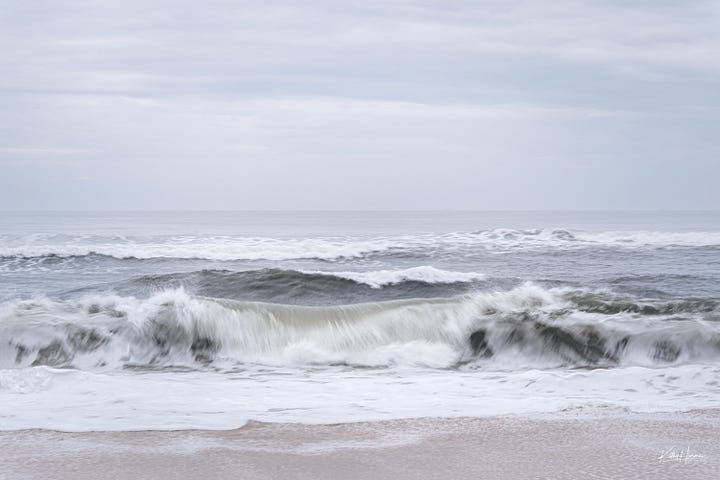
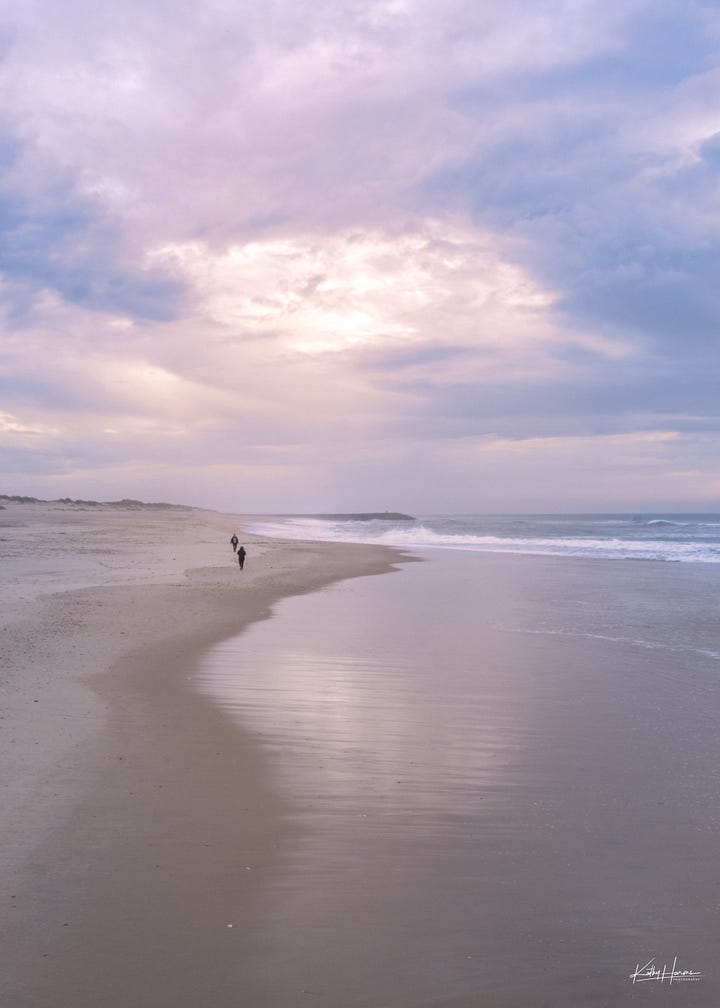
The houses in Costa Nova are interesting as well. The street where I stayed was lined mostly with tiny houses—many looked like single-room dwellings, and their front doors only reached my shoulders. One, a few doors down from me, had at least two people living in it, as I saw them several times on my walks. It must be pretty crowded in that little home.
Other homes are bigger, with two floors, but many of those have been divided into multiple apartments. Some have cheerful striped paint jobs, and others more traditional tiles.
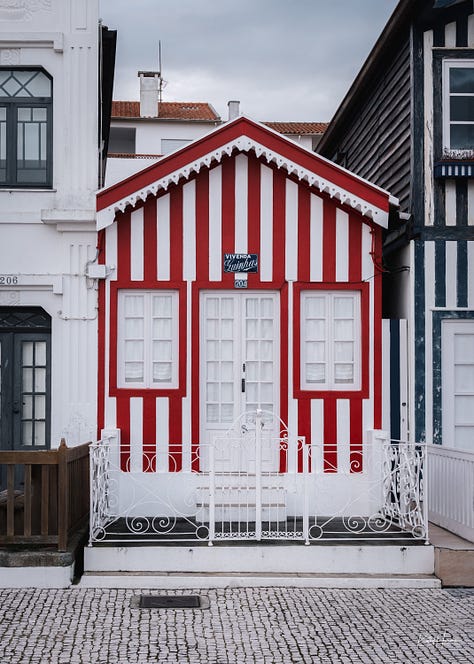
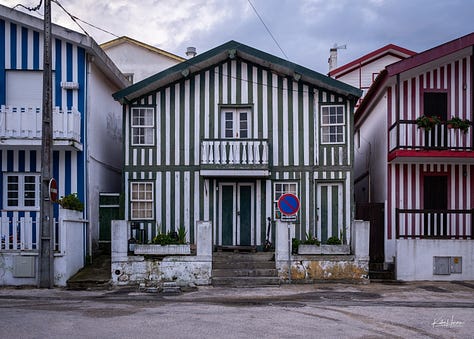
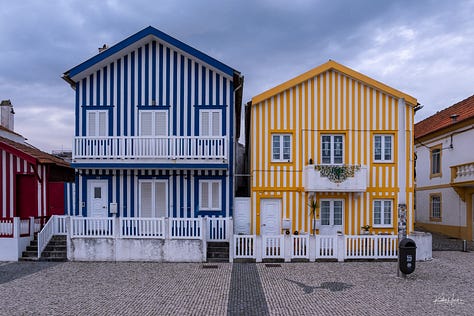
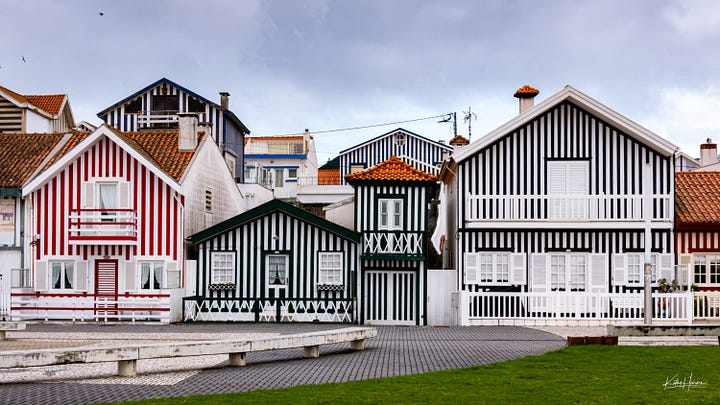
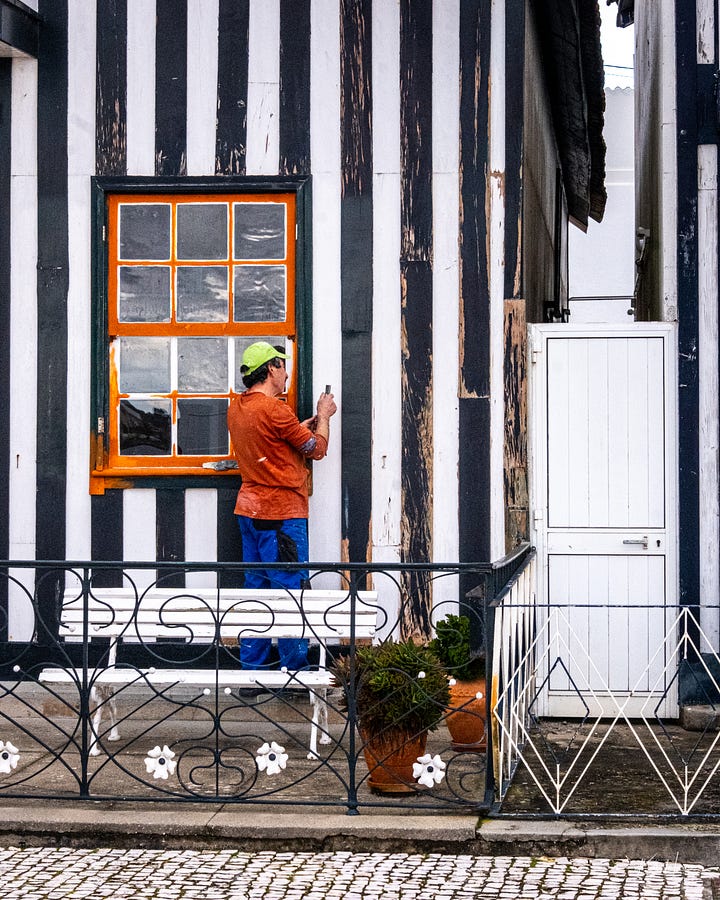
Of course, keeping the houses looking fresh and cheerful takes work, and I was delighted to spot the worker in the last image with his orange shirt, matching the orange trim of the cottage he was painting.
Last Thoughts
Thank you for following along as I share odds and ends from life and creative pursuits, and to those of you who opted in for a paid subscription, THANK YOU! There is a small token of my gratitude on its way to you in the mail for new paid subscribers.
There is also a little “bonus” at the end of this newsletter for paid subscribers, this week it’s a short video with a few more thoughts about the culture here in Portugal.
As always, I love hearing from you - your comments, questions, suggestions, or just a quick hello, they are all very welcome!
Até à próxima! (Until next time!)
Kathy
Keep reading with a 7-day free trial
Subscribe to The Journey to keep reading this post and get 7 days of free access to the full post archives.





